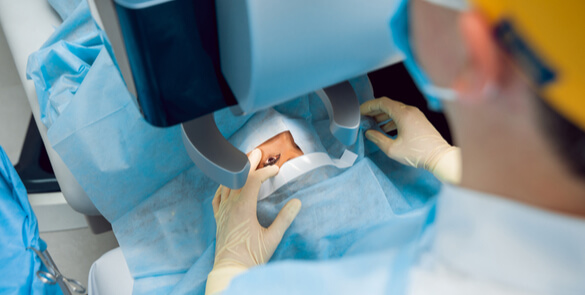Corneal Transplantation (PK)
Why do you need a corneal transplant?
The cornea is a window of transparent tissue at the front of the eyeball. It allows light to pass into the eye and provides focus so that images can be seen. Various diseases or injury can make the cornea either cloudy or out of shape. This prevents the normal passage of light and affects vision.
A cloudy cornea can be replaced by a healthy one from a donor to restore vision.If the full thickness of the cornea is affected by disease, then a full thickness transplant is performed. This is known as a penetrating keratoplasty.
Benefits of penetrating keratoplasty
Improved vision
- Approximately 75% of transplant recipients have vision sufficient to drive legally but may need glasses or contact lenses or sometimes further surgery for best results.
- It may take up to 18 months until the full improvement in vision is appreciated.
Risks of penetrating keratoplasty
Rare but serious complications
- Sight-threatening infection (1 in 1,000)
- Severe haemorrhage causing loss of vision
- Retinal detachment
- Severe inflammation or other rare causes of loss of vision
Corneal transplant rejection
A corneal transplant can be identified and attacked by your immune system. This happens in one in six patients in the first two years after transplantation and can cause graft failure. It can often be reversed if anti-rejection medication is started promptly.
Rejection remains a possibility for your lifetime.
Graft failure
When a graft fails, your cornea becomes cloudy again and your vision becomes blurred. This happens in one in 10 transplants for keratoconus in the first 10 years.
Glaucoma
This can usually be controlled by eye drops, but occasionally requires surgery and can damage the sight.
Cataract
This can be removed surgically.
About the operation
The operation
The operation is performed under general or local anaesthetic. The operation takes about one hour. A central 8mm button of your cornea is removed and a similar-sized button of the donor cornea is stitched in with tiny stitches (see front cover). These cannot be felt or seen. The abnormal cornea, which is removed, is sent to our pathology laboratory for examination under a microscope.
After the operation
You will usually be examined by the surgical team after the surgery and can generally go home the same day. You will be seen again within one week in the outpatient clinic and regularly thereafter (approximately six visits in the first year). We generally recommend that you take two weeks off work – discuss your individual circumstances with your doctor. You will need to use anti-rejection eye drops for at least six months and in some cases indefinitely. Individual
stitches may be removed from three months after the operation, but complete stitch removal is not performed until at least one year after the procedure.
What if my transplant fails?
A failed transplant can be replaced in a procedure known as a regraft, but the risk of subsequent rejection and failure increases each time for regrafts.
The percentages of full-thickness corneal grafts that are still functioning well five years after the operation under various conditions are:
| Condition | % |
|---|---|
| Keratoconus | 95 |
| Fuchs’ dystrophy | 80-90 |
| Stormal Scar | 80-90 |
| Stromal dystrophies | 80-90 |
| Bullous keratopathy | 50-80 |
| Bacterial infections | 50-80 |
| Herpetic keratitis | 50-80 |
| Fungal infection | 0-50 |
| 3rd or higher number regraft | 0-50 |
| 4 quadrants of blood vessels | 0-50 |
| Inflammation at time of surgery | 0-50 |
| Severe ocular surface disease | 0-50 |
| Grafts greater than 10mm | 0-50 |
Consenting for information sharing
We are required to share your information with the Eye Bank who supply donor corneas, to ensure high quality transplant material.
Corneal transplant rejection
Rejection needs urgent treatment as this can lead to failure of the transplant and loss of vision.
Symptoms of rejection are:
- Red eye
- Sensitivity to light
- Visual loss
- Pain
If you experience any of these symptoms, you should immediately call our 24-hour emergency phone line 055 516 1586.
